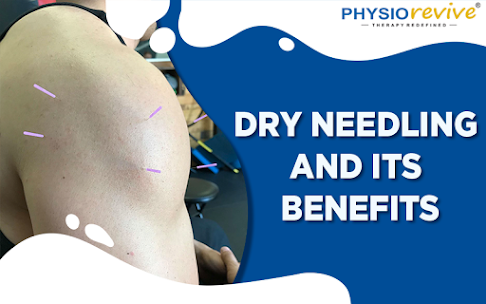Dry Needling and Its Benefits
Dry Needling, one of the popular techniques that physical therapists use to treat their patients from musculoskeletal pain, migraine, sports injuries, and many other illnesses. If your doctor has prescribed you this technique then it is important for you to know what it is and what to expect from dry needling. The expert at Physiorevive will provide answers to every question. Just be with us till the end.
What is Dry Needling Therapy?
Dry Needling is a skilled therapy and always performed by trained and expert physical therapists. In this therapy, a thin needle is inserted into the trigger points of the patient's body. It should not be confused with acupuncture. With the main aim of deactivating the trigger points and increasing the range of motion, the therapy is helpful with -
● Low back pain
● Migraines
● Shoulder pain
● Spinal dysfunctioning
● Sciatica
● Joint dysfunction
● Hip pain
● Knee pain
● Ankle sprains
● Muscle Strains
● And the list goes on
A trigger point is a hypersensitive muscle that is painful when compressed. These trigger points occur on the neck, back, and arms. For runners, the trigger point is on their legs. Neither any liquid nor any solution is injected, the needle is completely dry and that is why it is known as Dry Needling Therapy.
Benefits of Dry Needling Therapy
Physiorevive expert is sharing 3 major benefits of dry needling therapy that are -
● Improved Range of Motion
● Relieve Pain and Muscle Tightness
● Speeds Up Recovery & quick results
There is a lot of research that supports the fact that dry needling therapy is helpful in reducing muscle tension and improving pain control.
Also Read: Top Physiotherapy Myths Busted
What to Expect After Dry Needling Therapy?
You will definitely feel soreness after a dry needling session which is a quite similar feeling after strength training. In general, soreness is resolved within a day and you can take the help of cold and hot therapy or even gentle stretching.
To restore the function of your muscles quickly, a Physiorevive therapist recommends the following suggestions -
● Drink Sufficient Water -
When you are taking dry needling treatment, it is important to stay hydrated. It is helpful in reducing sore muscles.
● Rest to Your Muscles -
After the Dry needling session, it is advised to avoid intense workout of the same muscle and to allow muscle to relax. So, rest is important but also the gentle movements in the range which is achieved by the treatment should be followed.
● Exercise
Exercise is always beneficial whether you are taking a dry needling session or not. It helps to maintain the proper circulation of blood throughout the body. Follow the rehab program prescribed by your therapist. Stretching, working out, and some regular activities can be performed during this period.




Comments
Post a Comment